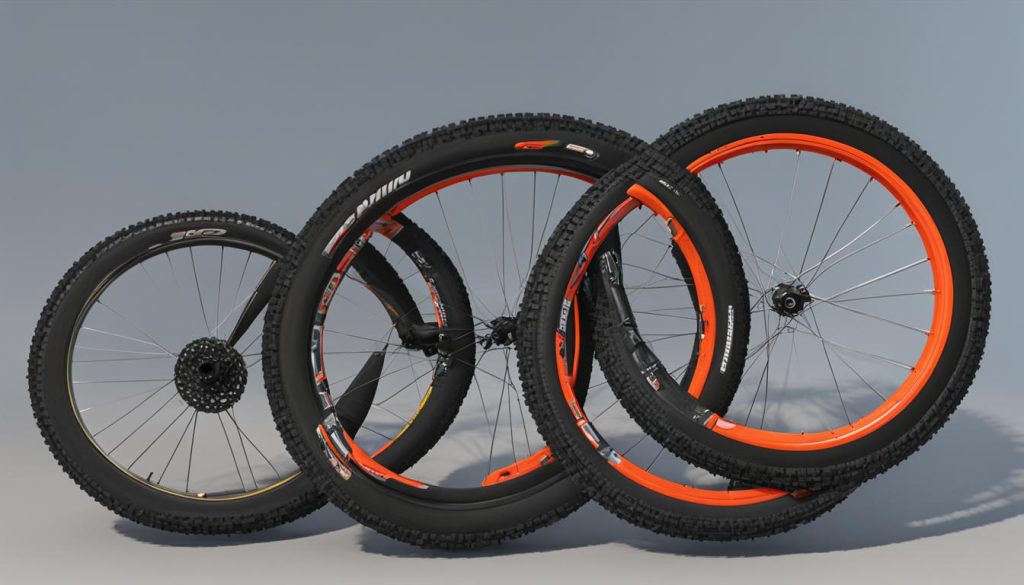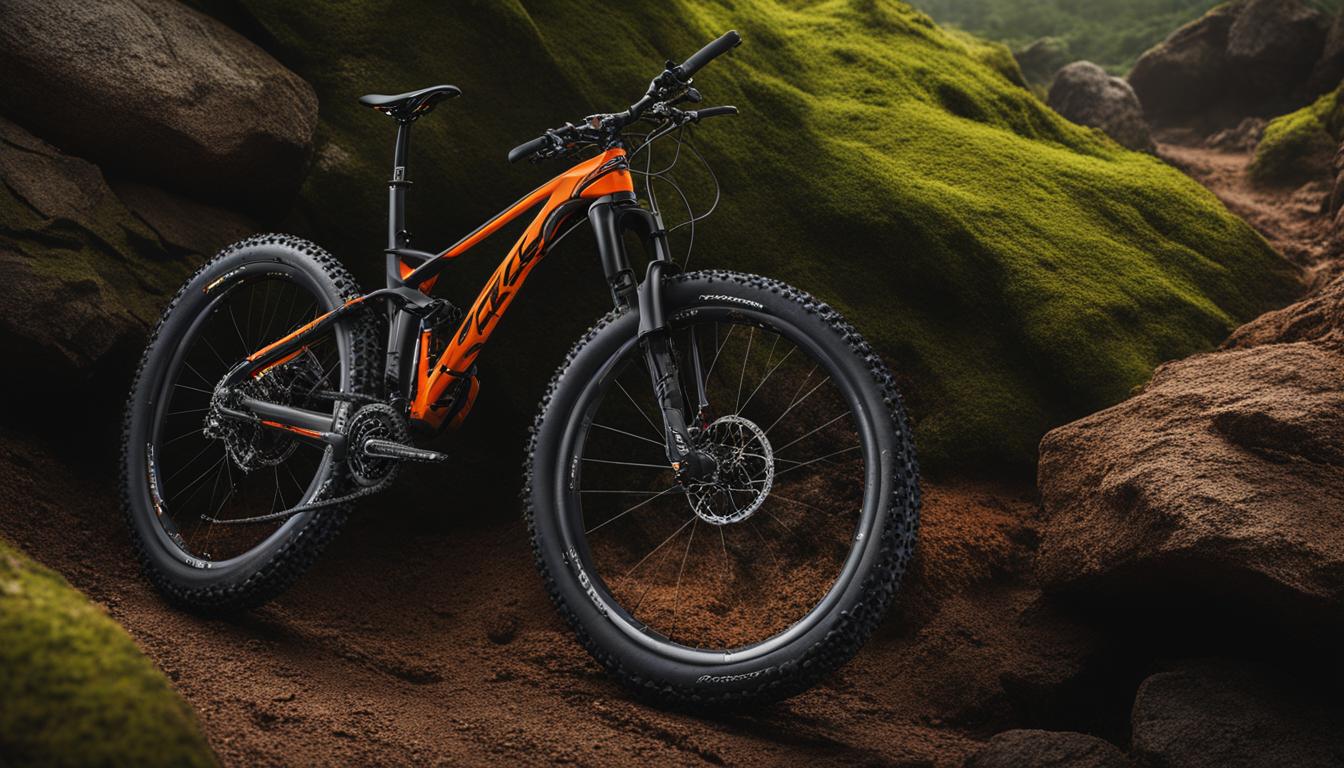When it comes to choosing the right bicycle tires, there are many factors to consider. Your riding style and the type of bike you have play a significant role in selecting the perfect tires. Whether you’re a mountain biker, road cyclist, or prefer hybrid biking, having the right tires can greatly enhance your riding experience.
Read More : How to Choose the Right Motorized Bicycle for You
Mountain bike tires are designed for off-road adventures, offering excellent traction and durability. They typically have wider widths and aggressive tread patterns, providing better grip on uneven terrains. Road bike tires, on the other hand, are ideal for smooth paved surfaces, prioritizing speed and low rolling resistance. Hybrid bike tires offer a versatile option, suitable for both road and light off-road riding.
Choosing the right tire width is also essential. Wider tires provide more stability and comfort, especially when riding on rough roads or trails. On the other hand, narrower tires are typically faster and more aerodynamic, perfect for road cyclists chasing speed records.
Another important consideration is the tread pattern. Some tires have a smooth tread for minimal rolling resistance on pavement, while others have a knobby tread for better traction on loose surfaces. Opt for a tread pattern that suits your riding conditions.
Additionally, deciding between wire and folding bead tires is crucial. Wire bead tires are more affordable, but folding bead tires are lighter, easier to install, and often offer better performance.
Finally, consider tubeless or tubeless-ready tires. Tubeless tires offer reduced puncture risk and better grip, while tubeless-ready tires allow you to convert to tubeless with the addition of sealant.
Key Takeaways:
- Consider your riding style and the type of bike you have when choosing bicycle tires.
- Mountain bike tires are best for off-road adventures, while road bike tires prioritize speed on paved surfaces.
- Hybrid bike tires offer versatility for both road and light off-road riding.
- Choose the right tire width for stability and comfort, or for speed and aerodynamics.
- Consider the tread pattern that suits your riding conditions.
Types of Bike Tires and How to Choose the Right Size
When it comes to choosing bike tires, there are various types available, each designed for different riding styles and terrains. Understanding the types of bike tires and selecting the right size for your bicycle is crucial for optimal performance and comfort. Here, we’ll explore the different types of bike tires and provide insights on how to choose the right size.
Tire Types
Road Bike Tires: These tires are designed for smooth surfaces and are characterized by their slick tread pattern. They offer low rolling resistance and are ideal for speed and efficiency on paved roads.
Urban/Commuter Bike Tires: These tires are wider than road bike tires and provide additional comfort and puncture protection. They are suitable for urban environments and can handle rougher surfaces, such as gravel paths or potholed streets.
Read More : Electric Bicycle: The Key to Reducing Traffic Congestion and Air Pollution
Gravel Bike and Cyclocross Tires: These tires are a hybrid between road bike and mountain bike tires. They have a moderate tread pattern that offers better traction on mixed terrains, making them suitable for gravel roads or cyclocross racing.
Mountain Bike Tires: These tires are wider and have aggressive tread patterns designed for off-road trails and rough terrains. They provide excellent grip and control, allowing riders to navigate through dirt, mud, rocks, and other challenging surfaces.
Choosing the Right Size Tire
Choosing the right size tire involves considering the wheel diameter and tire width. The most common wheel sizes for bikes are 26-inch, 27.5-inch, and 29-inch, with each size corresponding to a specific tire diameter. Additionally, tire width affects the ride quality, stability, and traction of the bike. Narrower tires offer less rolling resistance and are suitable for smooth surfaces, while wider tires provide better grip and cushioning on rough terrains. It’s essential to consult the tire manufacturer’s guidelines or seek advice from a bike shop to ensure you select the appropriate tire size for your specific bike model.

To summarize, selecting the right bike tires involves understanding the different types available and choosing the appropriate size based on your riding style and the terrain you’ll be encountering. Consider factors such as tread pattern, tire width, and wheel diameter to ensure a comfortable and safe biking experience.
When to Replace Bike Tires and Understanding Tire Features
Knowing when to replace your bike tires is crucial for your safety and performance on the road or trail. Here are some key signs to look out for:
When to Replace Bike Tires
If your tires are not holding air or consistently losing pressure, it may be time for a replacement. Decreased stopping power, especially in wet conditions, can also indicate worn-out tires. Check for any sidewall damage, such as cracks or bulges, as these can compromise the tire’s integrity. Additionally, worn tread patterns or bald spots on the tire surface are clear indicators that it’s time for new tires.
Wire vs Folding Bead
When choosing new bike tires, you’ll come across two main bead options: wire and folding. Wire beads are made of steel, providing durability and stability at a lower cost. On the other hand, folding beads are made of aramid fibers, making them lighter and more flexible. Folding bead tires are preferred by many riders for their ease of installation and portability.
Bike Tire TPI
TPI stands for Threads Per Inch, referring to the number of threads in one inch of the tire casing. Higher TPI generally indicates a more supple and lighter tire. However, tires with higher thread count may be more prone to punctures. Consider your riding style and the terrain you’ll be tackling to determine the most suitable TPI for your needs.
Tubeless/Tubeless Ready Tires
Tubeless tires have grown in popularity due to their ability to reduce punctures and provide a smoother ride. These tires use sealant and rely on a tight fit between the tire and rim to hold air, eliminating the need for inner tubes. Tubeless ready tires require additional sealing for air-tightness, but offer the benefit of allowing you to easily switch between tubeless and traditional tube setups.
FAQ
How do I choose the right bicycle tires for my riding style?
When choosing bicycle tires, consider your riding style and the type of bike you have. Different types of bike tires are available, including mountain bike tires, road bike tires, and hybrid bike tires, designed for specific terrains and riding conditions. Factors such as tire width, tread pattern, and tube choice are also important considerations.
What types of bike tires are available?
There are several types of bike tires to choose from, including road bike tires, urban/commuter bike tires, gravel bike and cyclocross tires, and mountain bike tires. Road bike tires are slick and fast, while urban/commuter tires offer wider widths for additional comfort and puncture protection. Gravel bike and cyclocross tires are a cross between road and mountain bike tires, suitable for mixed terrains. Mountain bike tires are wider with aggressive tread patterns for better grip.
How do I know when to replace my bike tires?
It’s crucial to know when to replace your bike tires for optimal performance and safety. Signs that it’s time to replace your tires include not holding air, decreased stopping power, sidewall damage, and worn tread patterns. For mountain bike tires, it’s recommended to replace them when side knobs or center knobs are damaged or worn. Road bike tires should be replaced when the tread is worn, there are cuts, or embedded debris is present.
What should I consider when choosing the right size tire?
When choosing the right size tire, you should consider the width and diameter. The width of the tire should be compatible with your bike frame and provide the desired performance characteristics. The diameter should match the size of your bike’s wheels. Additionally, it’s important to choose the appropriate tube and valve type to ensure proper inflation and compatibility with your bike.
How do I understand tire features like wire vs folding bead, tire TPI, and tubeless/tubeless ready tires?
Understanding tire features is important when choosing bike tires. Wire beads are less expensive but heavier, while folding beads are lighter and more flexible. Tire TPI (threads per inch) indicates the density of threads in the tire casing, with higher TPI tires offering smoother and more supple rides. Tubeless/tubeless ready tires eliminate the need for inner tubes, providing improved traction and puncture resistance.

